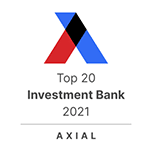
Achieving a successful exit from a company requires both careful preparation and extensive consideration of the many alternatives. Developing a strategy to maximize the value and avoid the pitfalls is critical.
In the article below, “Finding an Exit: Options and Their Implications,” Alain Chetrit shares the expertise he gained as CEO of First Regional Telecom and as a majority interest owner of HBS Holdings, the holding company for Hugo Boss stores.
Once the decision is made to sell a company, it is important to develop a strategy to maximize value and obtain the highest price available in the marketplace. Let’s examine the pros and cons of a variety of typical exit strategies:
PASS THE BUSINESS TO FAMILY
While this popular strategy may provide estate planning opportunities, ongoing cash flow to the entrepreneur and peace of mind for future generations, it does not necessarily maximize value for the selling owner. In fact, it is not unusual that a family sale leaves the business burdened with debt. The buying family member needs to have the skills and financial savvy to establish authority within the organization in order to generate profits. Mismanagement can render company worthless in a short period of time, not withstanding what it might do to family relations.
INITIAL PUBLIC OFFERING (IPO)
As an exit option, the dream of many entrepreneurs is, in fact, a rare exception. Notwithstanding the recent bubble, an IPO requires the confluence of a hot financial market, a hot business sector, outstanding results and excellent short-term prospects for the business.
Out of the millions of private businesses in the United States, the most robust years have seen only about 250 IPOs. According to VentureXpert, in 1999 and 2000, 257 and 232 respectively, venture-backed companies went public.
In many ways, for owners and/or managers, an IPO is not an exit, but rather a new beginning. In a typical transaction, the management team receives restricted stock, highly increasing the pressure to perform. An IPO is more of an exit for the investors in earlier rounds that it is for the owners/managers.
However, for companies that do successfully become public, the eventual rewards for the owners can be dramatic.
SALE TO A STRATEGIC BUYER
This exit approach generally yields the highest valuation at the time of sale due to the synergies a strategic buyer will realize from combining the businesses. A typical strategic buyer may factor the potential long-term synergies of combining operations into the offering price. However, after the sale, the longevity of the owner, management team and employee base can be at jeopardy. If conditions change, the acquirer may not have the same commitment and loyalty to the employees, causing aggravation to the former owners who now have little or no power.
If maximizing the valuation is critical, a significant portion of the purchase price will likely be stock in the acquirer’s company which raises another level of uncertainty and risk. While there are numerous entrepreneurs who have actually made more on appreciation of the acquirer’s stock than the value of their company, there are many who, in hind sight because of a drop in stock prices, wish they had pushed a little less on valuation and taken cash.
SALE TO A FINANCIAL BUYER
A significant number of Private Equity and LBO funds provide another avenue of exit for the business owner. Because these buyers generally will not recognize the same degree of synergies as a strategic acquirer, sale valuations almost always are lower.
However, the owners can generally get a “second bite at the apple” by retaining a minority interest in the business, which often can be boosted by achieving performance targets. While management longevity may be better than with a strategic buyer, independence still can be significantly reduced. Other factors also come into play, including control, leverage and the timing of the re-sale or “flip” of the business.
RECAPITALIZATION
This partial exit involves taking on debt and possibly outside investors in order to redeem a portion of the existing equity base. The owners can monetize a portion of the wealth they have created in the business and, at the same time, continue to own a significant piece of the equity.
But significant other issues come into play, including leverage, control and restrictive covenants. Highly leveraged or cash poor companies may no longer have the financial resources to weather unexpected economic conditions or even carry on their business. Moreover, creditors and shareholders may have a claim if the company becomes insolvent and no longer has the capacity to repay its debts.
STRATEGIES FOR VENTURE CAPITAL FIRMS
For Venture Capital (VC) firms, an exit is a clear goal from the time of an initial round of funding. Companies need to gain enough scale so that within three to seven years they can become candidates for IPOs, be sold or be merged. Alternatively, the company may provide a higher valuation for their VCs’ portfolios via an up round (new investment made at a higher valuation).
With an IPO market that is practically closed, portfolio companies that are not “stars” continue to require time and effort. It is generally in the VC’s interest to continue positioning the company for an exit, be it with a financial acquirer or a strategic buyer.
A gain is realized only when a sale transaction of some sort occurs. According to Jesse Reyes at Venture Economics, “9,900 venture-backed companies are still scrambling for the exits. Most of them won’t make it. A mere 22 went public in 2002.”
STRATEGIES FOR INSTITUTIONAL INVESTORS
For institutional investors investing in VC funds, if the fund does not reap the fruit of its investments within five to seven years, the likelihood of reinvestment in subsequent funds is diminished. For all investors, exits and ROIs are the scorecard. The availability of capital for the next group of entrepreneurs depends on the successful exits provided by the previous group.
Very frequently, VCs have “Put” rights that allow the VC to require that the company redeem the VC’s investment at fair market value, which most often occurs through a sale of the company. Additional terms can include “drag along rights” which essentially allow the VC to “drag along” all other owners if the VC is in favor of a sale of the organization.
SOURCES OF INFORMATION
Once the decision is made to sell a company, it is critical to develop a sound exit strategy in order to maximize value and obtain the highest price available in the marketplace.
Investment bankers and other professionals are an excellent source of information and may be able to connect the parties so that a CEO continues to run a business while an exit partner is identified and the highest value is derived.
FOCUS Enterprises hears frequently from private equity and buyout firms looking for candidate companies for which they will pay cash. The willingness of such buyers to pay cash is an offset to lower valuations in the current market environment.
Alain Chetrit is a Partner at FOCUS Enterprises, specializing in new technology, telecommunications and retail and franchise companies, with an emphasis on corporate finance, corporate development, marketing, positioning and investment banking services. Alain also has extensive international trade experience and is the recipient of the prestigious "M Award" for merchandising and marketing.












